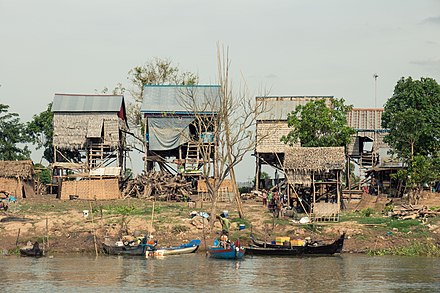Tonle Sap Lake - lake in Cambodia
Tonle Sap Lake is in Cambodia.
Understand
This lake is one of the most unique ecological water wonders in the world. It is the largest lake in Southeast Asia and changes in size and dimension every wet season. With a minimum size of 2,800 km² and about 1 m depth during the dry season, the lake is fairly small. During the wet season the water of the Mekong River becomes so powerful, that it reverses the flow of the Tonle Sap River and pushes the surplus of rain water back into the Tonle Sap Lake. This transforms the lake into a huge natural water reservoir and the lake's size increases to approximately 15,000 km² with a depth of 8 m.
The Tonle Sap River connects the lake with the River Mekong at Phnom Penh, in the southeast.
With the continuous change of the water level, the people who live on the lake have to move their houses away when the water level goes down. Whole villages including schools, shops, churches and pig farms are towed to somewhere the water is still deep enough to float.
History
The lake has been inhabited throughout history, with earlier records coming from a Chinese diplomat in the 14th century who disembarked his boat at the lakeside town known today as Kompong Khleang.
In 1997 the lake was designated as a protected area under UNESCO's Man and Biosphere programme.
Landscape
Flora and fauna
The unique embankment has a rich biodiversity of fish, birds, reptiles and other mammals around the lake. The aquatic habitat provides 75% of the inland fishing catch and supports over 3 million people with food. The lake houses over 300 species of fresh water fish, 20 varieties of snakes, 10 varieties of turtles, a species of crocodile and a species of leopard cat.
There is a bird sanctuary at Prek Toal between Siem Reap and Battambang.
There are huge giant catfish here, with record specimens up to 300 kg. This endangered species is confined the Mekong and surrounding rivers and lakes.
A large crocodile farming industry thrives on and around Tonle Sap. The main species is the Siamese crocodile, critically endangered in the wild. The lake also provides a habitat for 13 species of turtle.
Climate
The best time to visit is the dry season (November - April), when the water level falls and the birds are concentrated in a comparatively small area.
Get in
.jpg/440px-Tonle_Sap_(7).jpg) The passenger ferry from Phnom Penh to Siem Reap (6 hr) travels up the Tonle Sap River, stopping at Kampong Chhnang, and travels straight across the lake. It is a good way of viewing the Tonle Sap and all activities on it, if a little fast.
The passenger ferry from Phnom Penh to Siem Reap (6 hr) travels up the Tonle Sap River, stopping at Kampong Chhnang, and travels straight across the lake. It is a good way of viewing the Tonle Sap and all activities on it, if a little fast.
The passenger ferry between Battambang and Siem Reap (5-8 hr) crosses the northwest corner of the Tonle Sap, but spends the majority of the journey on the Sangke River. It is considered by many as the best boat trip in Cambodia.
The Tonle Sap and its many floating villages can be accessed from Siem Reap, Kompong Phluk, Kompong Khleang, Phnom Penh, Kampong Chhnang, Kompong Luong and Battambang. At all these locations on the lake, tourists are able to rent a boat and driver. Price varies, and is per person or per boat.
Fees and permits
Get around
See

- Chong Kneas: A large floating village about 15 km south of Siem Reap by paved road. The situation here has been complicated in the 2010s, with the visitor experience now in a bad state. It is still the most frequented village on the lake, but for those visitors who want a peaceful trip free from scams, caution should be taken when booking up.
- Meachrey
- Kompong Phluk a stilted settlement on a tributary to the lake, approximately 20 km south east of Siem Reap. Between the village and the lake, a flooded forest can be explored with a hired boat (and navigator). There is a small floating settlement too where the tributary meets the lake. The experience is becoming more and more geared up for visitors, and scam practices of Chong Kneas are beginning to show. To assure a tranquil experience read up before visiting.
- Kompong Khleang
- Prek Toal
- Kompong Luong

